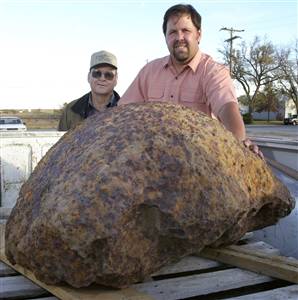
Meteorites are fascinating objects to think about. Somewhere back in history a rock from space came crashing down to our planet. This happens more often than one might think. We are not talking about the giant “Earth Enders” we see on tv, but something usually quite smaller. These spaces rocks are scattered all over the earth just waiting to be discovered. How do we find them? Can a metal detector be used?
Most meteorites contain a least a little amount of iron and/or nickel. Therefore, most meteorites can be found using a metal detector. Here is what you need to know find meteorites.
Meteorite Basics
First thing we need to consider when hunting for meteorites is some basic science. A meteorite is a rock that has come from space, made it through our atmosphere, and has impacted the ground. Sometimes these meteorites hit in one piece, other times they are in multiple pieces upon impact.
As these rocks fall to earth, they break apart and scatter across an area. There are two ways this can happen, in the air or upon impact. The search area will vary depending on what happened as this meteorite entered our earthly realm. These search areas are called “Strewn Fields”.
If the meteorite broke into multiple pieces before impacting the ground then this is called “Mid-Air Fragmentation”. When this happens the strewn field will be an elliptical or oval shape with the flight path of the meteorite passing through the middle. This happens because the rock breaks into different size pieces and the smaller ones tend to fall faster and the larger heavier pieces land somewhere in the middle.
Sometimes meteorites will hit the earth in relatively one large piece. The resulting impact will then cause the meteorite to explode into smaller pieces scattered throughout the strewn field. When this occurs it is called “Impact Fragmentation”. This results in pieces flying off in all directions relatively equally. This strewn field will resemble more of a circle.
Type of Detector
There are numerous types and brands of detectors available on the market today. Some are better for finding different items than others. So what type of detector do you need to hunt for meteorites?
The answer is quite simple, almost any detector will work. As stated above, most meteorites contain iron and or nickel in their composition. Virtually all metal detectors can detect iron. It is important to turn off any discrimination because we are actually looking for the elements that most discriminators ignore.
Where to Look

Now that we have a basic understanding of what happens when a meteorite hits earth we can use that information to narrow down our search area. Although meteorites are scattered throughout the earth, we can employ some strategies to increase our chances of finding something from out of this world.
One method is to look for known strewn fields and hunt those areas. There are multiple resources online for showing these spots. An example is listed below in the resources section. These areas have most likely already been hunted but this does not mean that some have not been overlooked.
Some of these areas are on current or previous farm lands. This results in the ground being subject to repeated disturbance due to normal farming activity such as tilling. A good idea would be to look for rock piles around the area. It is a common practice for farmers to remove rocks and place them in a central pile.
Another good place to look is on open lands that have scarce terrestrial rocks. Deserts and plains are great places to look. Not only are they devoid of rocks, but the terrain is easily traversed and contain prime digging conditions.
Be sure and get permission before hunting any ground. If the land is privately owned then seek permission from the landowner. If the land is public or government owned check with appropriate local agencies.
What to Look For
Detecting for meteorites is not quite the same as a normal detecting adventure. Typically one is looking for something that is visually out of the ordinary such as coins, nails, horseshoes, etc. However, when hunting for space rocks we are looking for just that, rocks.
Some of these rocks may be very small, pebble sized in fact. However some can be quite large as pictured below.

Our first clue is the most obvious one, it registered on the detector. If a signal is given and the pinpointer leads you to a rock, then this is a good indiction that you may have found a meteorite.
Another tool meteorite detectors use are rare earth magnets. These super strong magnets are more useful than normal magnets as these small rocks may only contain a very small amount of iron in them. Normal magnets may not have a strong enough attraction to the iron to stick. Magnetism is another indication that you may have found a space rock.
Hot Rocks
The term “Hot Rock” applies to any rock that has a high amount of metal ore in its composition. Many terrestrial rocks contain metal ores and will set off a metal detector. These Hot Rocks are not necessarily a meteorite. These rocks have tricked numerous hunters.
How to Know

So finding meteorites also results in finding terrestrial rocks as well, how can we tell if we have found something from out of this world? There are a few items one can bring along to help increase confidence in your find being a meteorite. One such item is nickel testing solution. The presence of nickel is a good indication that the rock you are testing might be a meteorite. This, along with others can be purchased here.
The only way to know for sure if you have found a meteorite is to send it off to be tested. In the past many universities would test these rocks for you, but due to the fact that most samples are not from space, most of these are no longer accepting specimens from the public. One website that offers some helpful information about these labs can be found using the link below in the resources section. Do your research before sending any specimens so as not to be scammed.
Other Unique Items
As with any hunt, one can expect to find some interesting things that they were not necessarily seeking. Arrowheads are a good example of this. If one is hunting in the high plains keep a look out for these Native American artifacts.
A unique item that one might come across hunting an actual meteorite landing site is a Tektite. According to Encyclopedia Britannica a Tektite is:
Tektites have been the subject of intense scientific scrutiny throughout much of the 20th century owing to their unknown and possibly extraterrestrial origins, but they are now recognized as having formed from the melting and rapid cooling of terrestrial rocks that have been vaporized by the high-energy impacts of large meteorites, comets, or asteroids upon the surface of the Earth.
These unique “rocks” are melted silica and glass like in appearance. Therefore they are most likely not detectible via a metal detector. They are either green, dark brown, or black in color. Their shapes vary across the circular spectrum such as ovals, teardrops, and buttons etc. Keep an eye out for these amazing glass rocks when hunting.
What to Do With A Found Meteorite
Once you have hunted, retrieved, and confirmed that you have in fact found a meteorite, what should you do with it? There are a few options.
The first option would be to simply keep it in your private collection. These rocks look great on display and are excellent conversation pieces. The other option would to be to seek out scientific considerations. Each meteorite can help provide data for scientists that study these amazing rocks. This option may require one to donate a piece or the entire specimen to the research facility or museum.
No matter what you choose to do with your finds, hunting meteorites can be a fun hobby. Have fun and stay safe!
Resources
https://www.britannica.com/science/meteorite-shower#ref915755
Shooting Star Photo by averie woodard on Unsplash
Map Photo by Capturing the human heart. on Unsplash
Lab Photo by Louis Reed on Unsplash
